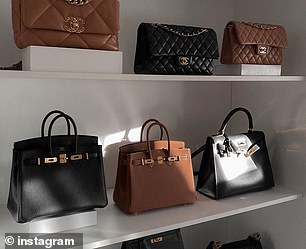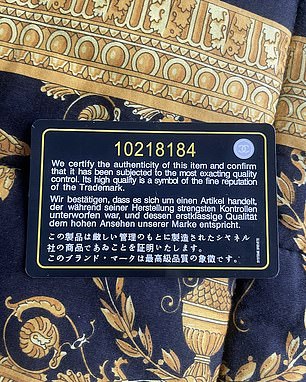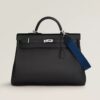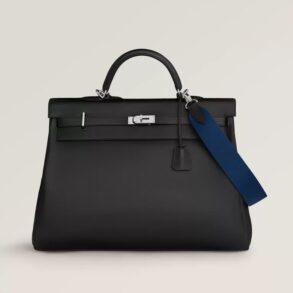- Authenticators explain exactly how to figure out if your secondhand bag is legit
- It’s important to know the signs before sending it for a second opinion
- However, even some authenticators have been accused of getting it wrong
It’s more difficult than ever to know whether a designer bag is real or fake – which is the point if you’re hoping to buy a knockoff handbag that looks uncannily like the legitimate thing, but an issue if you’re hoping your secondhand buy is authentic.
Unfortunately, getting a luxury bag authenticated doesn’t always mean it’s real, as counterfeits get even more convincing with super fakes on the rise.
Many times, authenticators can incorrectly identify a bag if they aren’t experts on the designer and the handbag’s deep history.
To find out how to guarantee your expensive designer bag isn’t a dupe, FEMAIL talked to authenticators on how to get it right – and why some get it wrong.



Why should you authenticate your luxury bag?
It can be extremely difficult to figure out if a bag is real or not with the rise of super fakes.
One handbag lover detailed a ‘nightmare situation’ on Reddit: ‘I purchased a vintage Fendi bag on Friday for $700. When it was delivered, I immediately noticed some red flags (wonky stitches, chipped leather) which were not disclosed in the original listing.’
After having the bag authenticated by three different third-party services, two came back as authentic and one determined it to be counterfeit.
One person on Reddit broke down the authentication process, explaining: ‘Some will authenticate most major brands, others might specialize. Pricing ranges $25-$50 per bag, maybe more depending on the service.’
‘Authenticators will require very clear, up close photos. I had to use a macro lens attachment for my phone to get close ups of the details and texture,’ they continued.
‘There are some you can pay more and ship the bag for in person inspection,’ and people can also bring the bag into the original design house, although that’s not always the best technique.
Another Reddit user wrote: ‘I get a lot of my bags from places that authenticate but I always authenticate myself and then get a second opinion just to be safe. If I’m spending hundreds or thousands on a bag I need to be sure it’s legit.’
For those who want to start learning how to begin authenticating on your own, there are a few easy tips.



What should you look for when purchasing a pre-owned handbag?
San Antonio, Texas-based Zekrayat Husein, 42, runs Zekos Authentication, which has rave reviews, making her a true expert on what to look for.
‘Due to the prevalence of high-quality counterfeit handbags, it’s essential to authenticate before purchasing,’ Zekrayat warned.
‘When evaluating casually, confirm that the bag’s color, leather type, size, and hardware are consistent with the era of its production.’
Zekrayat advised initially checking if the serial number matches the production date and assessing the bags structure to make sure it looks ‘perfect when stuffed and upright.’
‘Don’t be overly concerned about minor flaws, as these can actually indicate authenticity, as genuine bags are often hand-assembled rather than machine-made, which can lead to small imperfections,’ Zekrayat advises.
Instead, ‘pay close attention to heat stamps, as they can reveal much about a bag’s authenticity,’ citing the classic Chanel flap as an example, as it’s exclusively made in France.

How do you choose where to buy your bag?
New York City-based Vidyuth Srinivasan, co-founder and CEO of Entrupy, which authenticates bags using advanced AI, said it’s important to see if companies used verification services when buying luxury goods.
‘The significance lies in ensuring that websites utilize a third-party authenticator for verification,’ Vidyuth explained, adding that Entrupy operates independently, which means ‘the emphasis is on providing an accurate result for our customers and consumers.’
Vidyuth suggested consumers ask about the verification process during the purchase or seek post-purchase verification for added assurance.
Should you bring your bag into the brand’s boutique?

Washington, DC-based Emily Erkel – co-founder and CMO of luxury pre-owned wholesaler LePrix – advised ‘not always relying on bringing items into the brand boutique.’
‘While many sales associates are very knowledgeable in the newest season, they may not be well versed or have been exposed to a vintage piece from 20 years ago,’ Emily explained.
Instead, Emily said ‘it’s better to rely on the authentication experts in the pre-owned industry.’
Expert authenticators know everything from the types of threads to stitching techniques used.
Just make sure to check the authenticator’s reviews ahead of time to make sure they always get it right.
What handbags should you avoid buying?
‘In the world of secondhand, if a bag is a best seller, it most likely has a dupe,’ Emily claims.
‘Even if it’s not a best-seller, the counterfeit industry still could fake one,’ she adds, listing Dior Book Totes ($3,350), the Louis Vuitton Neverfull ($2,100) and Gucci Marmont ($2,550) as oft-replicated items.
Vidyuth cited Louis Vuitton, Chanel, Goyard, Dior, and Saint Laurent as brands that are more frequently replicated.


Zekrayat says ‘it’s important to remember that the bestselling bags are often the ones most precisely faked,’ naming the most sought-after and duplicated high-quality counterfeits in order as the Classic Flaps ($10,000), Boys ($6,100), Coco Handles ($6,900), and the 19s ($6,400).
After Chanel increased bag prices again in March, most of the brand’s Classic Flap ones retail for more than $10,000, which has led to a rise in fakes
‘When buying online, opting for seasonal bags may be wiser, as counterfeiters typically don’t prioritize them, given their lower demand,’ Zekrayat advises.
‘Counterfeiters frequently use authentic flaps to produce high-quality fakes, yet they tend to overlook the subtle, season-specific details.
‘To this day, I have yet to see an exact, mirrored or identical twin replica of any bag; there are close copies, but they are merely fraternal twins, not exact duplicates.’
This post was originally published on this site be sure to check out more of their content.






